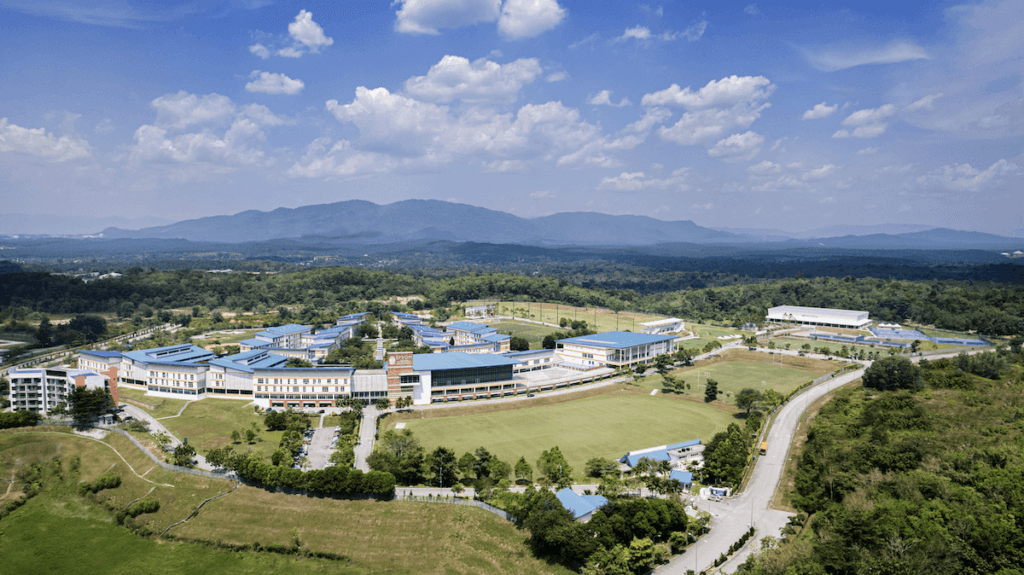Guide to US Applications • Undergraduate
Unveiling the 5 Best Non-Ivy League Colleges of 2024
POSTED ON 01/23/2024 BY The Red Pen

The term “Ivy League” made its way into the American lexicon in the early 1930s when Caswell Adams, a sports journalist at the New York Herald Tribune, used it to characterise the formation of an emerging athletic conference. Today, it has become synonymous with prestigious institutions such as Harvard University, Yale University, University of Pennsylvania, Princeton University, Columbia University, Brown University, Dartmouth College, and Cornell University. Perceived as selective and elite, people recognise them for their unparalleled education. However, it’s essential to remember that the US boasts several other equally competitive and selective universities beyond the Ivy League, providing excellent opportunities for a world-class education. A recent study revealed that 89 percent of Fortune 500 CEOs attended non-Ivy League institutions. In this blog, we’ve handpicked the top five non-Ivy League colleges of 2024 that offer excellent educational opportunities.
1) Massachusetts Institute of Technology (MIT)
Type: Private
The Massachusetts Institute of Technology (MIT) is a distinguished research university in Cambridge, Massachusetts, renowned for its science, engineering, and technology programmes. It includes the School of Architecture and Planning, the School of Engineering, the School of Humanities, Arts, and Social Sciences, the MIT Sloan School of Management, the School of Science and MIT Schwarzman Computing College. Each school provides degrees in their fields and options for minors and concentrations. Classes are open to students regardless of their major or department. Students can pursue traditional, interdisciplinary, joint degrees or double majors.
Facilities at the university include the MIT Libraries, Computing on Campus, Makerspaces, and notable centres, laboratories and programmes. MIT’s Lincoln Laboratory is a federally funded research and development centre that develops advanced technology to address national security needs.
Research lies at the heart of the university. Over 85 percent of MIT undergraduates enhance their education by participating in faculty-led research, thanks to the Undergraduate Research Opportunities Programme (UROP). MIT’s groundbreaking research in robotics, AI, and renewable energy has driven technological advancements, ranging from digital circuits to ingestible robots.
The university empowers inventors to translate cutting-edge scientific discoveries into transformative innovations by facilitating connections with mentors, collaborators, networks, and funding. Due to this, MIT has made a global impact in 150 different ways.
The institution’s association with 91 Nobel Prize winners reflects its academic excellence. MIT also provides a personalised learning experience with a notable 3:1 faculty-to-student ratio.
MIT is renowned for its thriving research ecosystem, where over 85 percent of undergraduates actively participate in faculty-led research through the Undergraduate Research Opportunities Programme (UROP). 58 percent of undergraduates receive MIT Scholarships, and the institution has an impressive 99 percent freshman retention rate.
2) Stanford University
Type: Private
Stanford University, located in the heart of Silicon Valley, California, is widely acclaimed for its exceptional academic programmes. Among the 67 major fields of undergraduate study, computer science, engineering, sustainability, humanities, and social sciences stood out as the ten most enrolled courses in 2023.
The university is also a leader in research, allocating more than $5.9 million annually to support undergraduate research. It boasts 15 autonomous laboratories, centres, and institutes, facilitating physical and intellectual collaboration across various disciplines. Students can conduct independent research or participate in research across 30 departments. They can also pursue honours programmes in their senior years and engage in advanced, independent research, analysis and articulation with faculty guidance.
Stanford students are encouraged to broaden their horizons and gain diverse experiences by participating in programmes such as the Stanford Diversity Exchange, Stanford in New York, and the Stanford in Washington Programme. The university’s prestigious faculty includes 21 Nobel laureates and four Pulitzer Prize winners. The university also boasts a notable alumni track record with 74 billionaires and 17 astronauts. A low student-faculty ratio of 5:1 offers an intimate learning environment. The average freshman retention rate, an indicator of student satisfaction, is 95 percent.
A large percentage of students at Stanford benefit from financial assistance. Among them, 58 percent are awarded scholarships directly from Stanford, encompassing athletic scholarships. Additionally, 49 percent receive need-based scholarships from Stanford, contributing an average of $16,300 towards their expenses after factoring in all grant aid.
3) California Institute of Technology (Caltech)
Type: Private
Located in Pasadena, California, the California Institute of Technology (Caltech) is a globally acclaimed institute for science and engineering, bringing together brilliant minds and cutting-edge tools to tackle essential scientific queries.
Renowned for its rigorous curriculum and small class sizes with a 3:1 student-faculty ratio, Caltech offer 28 undergraduate majors across six academic divisions: Biology and Biological Engineering, Chemistry and Chemical Engineering, Engineering and Applied Science, Geological and Planetary Science, Humanities and Social Sciences, and Physics, Mathematics, and Astronomy.
All Caltech students complete the same core curriculum, with advanced sciences, humanities, and social sciences courses, regardless of their majors. The University also offers Cross Registration opportunities for students to pursue courses that it doesn’t provide at nearby institutions like Occidental College and ArtCenter of College Design. Students can also opt for an exchange opportunity for a fall term at the University of Chicago.
Caltech is home to over 50 research centres and institutes, and an impressive 90 percent of undergraduates engage in research during their time at the university, regardless of their major. The university oversees NASA’s Jet Propulsion Laboratory (JPL), launching probes to study our solar system’s planets and monitor changes on Earth. Caltech runs major research facilities like the Caltech Seismological Laboratory and a worldwide network of observatories, such as Palomar, W. M. Keck, Owens Valley Radio Observatory (OVRO) and the Laser Interferometer Gravitational-Wave Observatory (LIGO).
Caltech also features the Interdisciplinary Studies Programme (ISP), enabling students to design their academic requirements under faculty supervision, such as pursuing a Bachelor of Science in Materials Science. Notably, Caltech has a strong track record, with 46 alumni and faculty winning 47 Nobel Prizes. The institution maintains a remarkable 3:1 student-faculty ratio, ensuring close interaction with professors, and it boasts an impressive average freshman retention rate of 97 percent. 51 percent of students receive financial assistance, making education accessible to a diverse range of students.
4) Duke University
Type: Private
Duke University in Durham, North Carolina, has five undergraduate schools, including Trinity College of Arts & Sciences, Pratt School of Engineering, Nicholas School of the Environment, Sanford School of Public Policy and Duke Kunshan University. It offers a comprehensive selection of 53 majors, 52 minors, and 23 certificates, with 83 percent of students opting for more than one major. Among these, the top five majors are Computer Science, Economics, Public Policy, Biology, and Electrical and Computer Engineering.
Students whose intellectual interests cross departmental boundaries or those who perceive areas of learning in clusters other than others offered in majors can also design their own majors through Prorgam II. Programmes like “Visual and Media Studies and Computer Science” and “Linguistics and Computer Science” exemplify Duke University’s distinctive interdisciplinary education approach.
Duke University’s defining characteristic is its commitment to social impact, exemplified by programmes like Bass Connections and DukeEngage, where students engage in research to address complex societal issues and promote meaningful community engagement.
The university is also known for its research. It owns the Duke Lemur Center, a world leader in studying, caring for, and protecting these endangered primates and is affiliated with Duke University Medical Center. It owns and manages Duke Forest, an outdoor laboratory for those studying ecosystems, biodiversity, and sustainable resource management.
The university has several award-winning professors, maintains an impressive 5:1 student-faculty ratio, provides financial aid to 51 percent of its undergraduates, and has an outstanding 98 percent freshman retention rate. Duke University’s notable alumni include Apple CEO Tim Cook and Melinda Gates, co-founder of the Bill and Melinda Gates Foundation.
5) Johns Hopkins University
Type: Private
Johns Hopkins University, situated in Baltimore, Maryland, provides a diverse selection of 52 undergraduate majors and 50 minors across its nine divisions. The university operates on four campuses in Baltimore, one in Washington, D.C., and maintains facilities in the broader Baltimore-Washington region, as well as in China and Italy.
Johns Hopkins University offers 400 programmes across arts and music, humanities, social and natural sciences, engineering, international studies, education, business, and health.
You can pursue a cost-effective and efficient path at Johns Hopkins by combining your undergraduate studies with one of Hopkins Engineering’s 14 master’s programmes in engineering. Additionally, the university offers interdisciplinary options like a Bachelor’s in Engineering/MBA through JHU’s Carey Business School. You can also explore combined bachelor’s and master’s degrees in International Relations and Global Health Studies right after matriculation.
Johns Hopkins University, America’s first research university, has 80 percent of undergraduates involved in formal research during their academic journey. The university assists students in finding and funding research opportunities through the Hopkins Office for Undergraduate Research (HOUR), where you can apply for grants to support your ideas.
Johns Hopkins’ Life Design Lab provides essential services like networking events, résumé workshops, and mock interviews to help you achieve your career goals. Prestigious employers such as Amazon, Malala Fund, Google, NBC Universal, and Microsoft actively recruit Hopkins students for their exceptional preparation and unique perspectives.
Johns Hopkins’ Global Education Office collaborates with major universities in 50 countries across Africa, Asia, Europe, Latin America, the Middle East, and Oceania. With programme durations ranging from a few weeks to a full year, you’ll discover study-abroad opportunities perfectly aligned with your undergraduate interests and schedule.
Johns Hopkins has a prestigious history, with 29 individuals associated with the university receiving Nobel Prizes, including four current faculty members. The institution maintains a favourable student-faculty ratio of 6:1, fostering a personalised learning environment and one-on-one advising. University’s 54 percent of students receive financial aid, and the average freshman retention rate is 97 percent, indicating high student satisfaction.
| College | Undergraduate Enrollment | Acceptance Rate | SAT/ACT average | Annual Tuition | International Students |
| MIT | 4,576 | 4.8% | 1520-1580/34-36 | $59,750 | 10% |
| Stanford University | 7700 | 3.68% | 1500 – 1580/33 – 35 | $ 61,731 (20,577 per quarter) | 16% |
| Caltech | 1023 (for Fall 2023-24) | 3% | – | $60,816 | 12% |
| Duke University | 6,543 | 6% | 1520-1570 | 63,450 | 14% |
| Johns Hopkins University | 5,253 | 7% | 1530-1560/34-35 | $62,840 | 14% |
Source: University websites.
Disclaimer: Information is subject to changes; kindly verify details on individual university websites.
Non-Ivy League colleges in the US offer valuable opportunities. To maximise your chances, carefully review admission requirements and submit your application before the deadline.
You may read our latest blogs on The Ultimate Guide to Undergraduate Courses in the US and Nuances of How to Apply to Undergraduate US Universities. But if you’re looking for an undergraduate admissions consultant who will enhance your chances of acceptance to US Universities, please get in touch. Our experts look forward to hearing from you.





